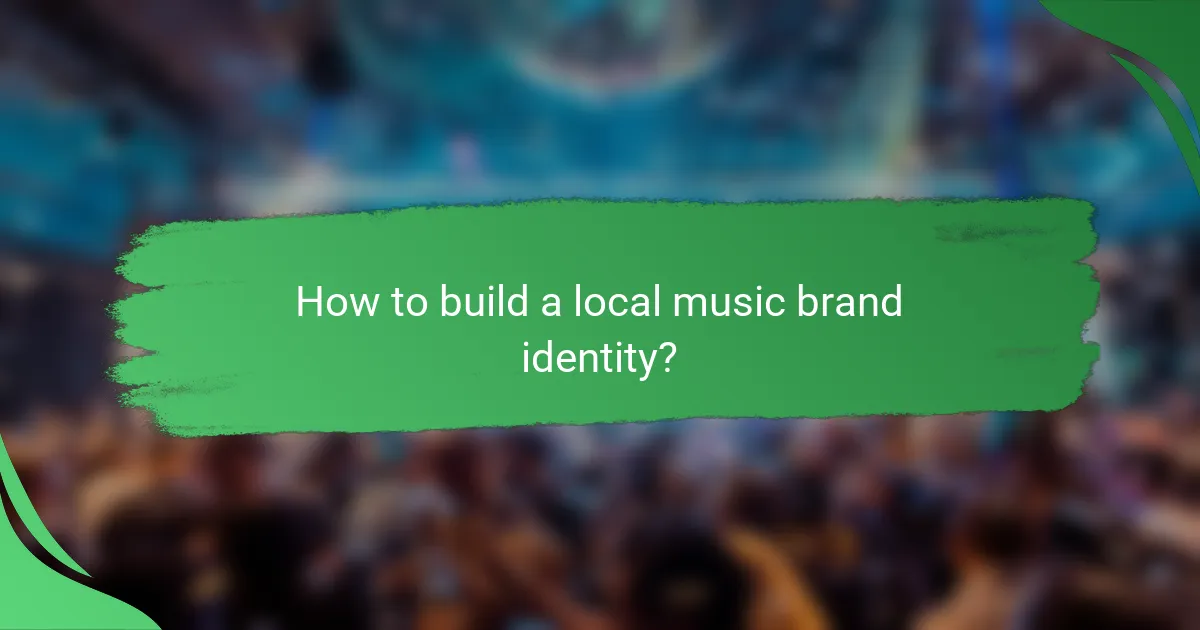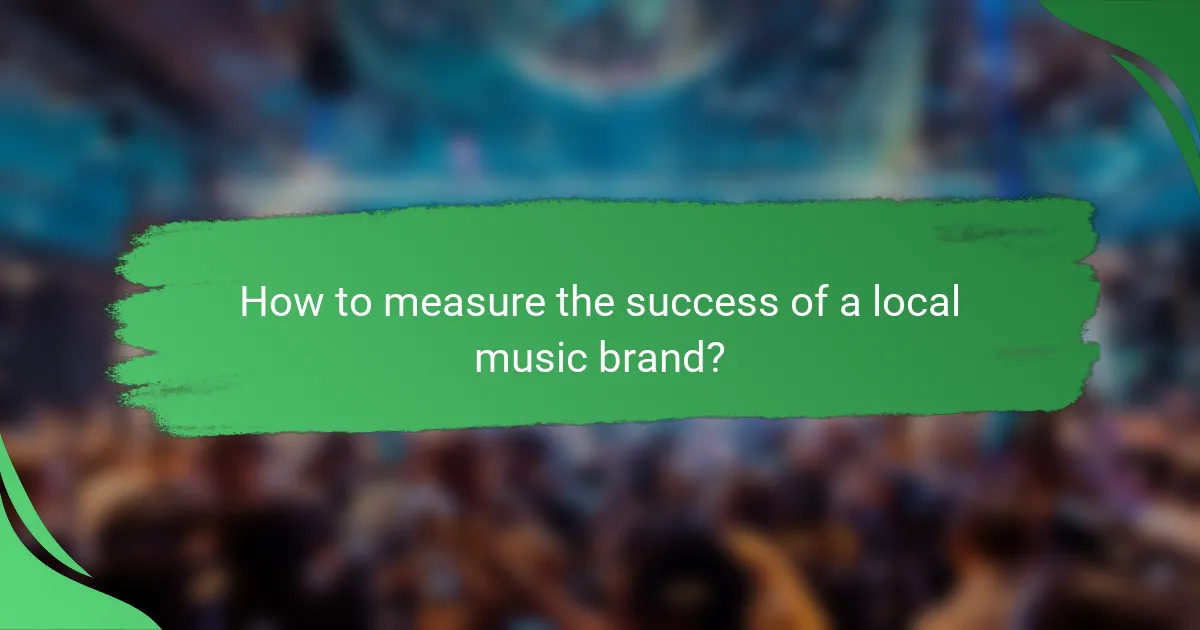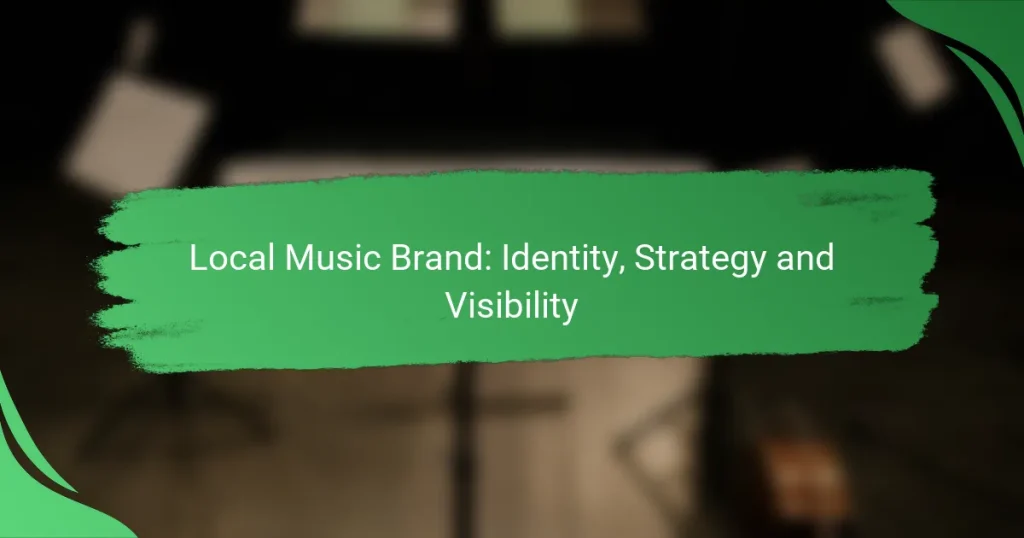Creating a strong local music brand identity is essential for establishing a unique presence within the community. This involves defining core values, developing visual elements, and engaging with local culture. To increase visibility, brands can utilize social media, collaborate with influencers, and participate in community events, ensuring they connect meaningfully with their audience.

How to build a local music brand identity?
Building a local music brand identity involves defining your unique values and creating a recognizable presence in your community. This process includes establishing visual elements, a consistent voice, and engaging with local culture and artists.
Define brand values
Brand values are the core principles that guide your music brand’s actions and decisions. They should reflect what your brand stands for, such as authenticity, community engagement, or innovation. Clearly articulating these values helps you connect with your audience and differentiate from competitors.
Consider creating a list of 3-5 key values that resonate with your target audience. For example, if your brand focuses on promoting local talent, values like “supporting local artists” and “community collaboration” could be central to your identity.
Create a unique logo
A unique logo is essential for visual identity and brand recognition. It should be simple, memorable, and reflective of your brand values. Consider hiring a graphic designer or using online design tools to create a logo that stands out in the local music scene.
Ensure your logo is versatile for various applications, such as merchandise, social media, and promotional materials. Test it in different sizes and formats to confirm its effectiveness across platforms.
Establish a consistent voice
Your brand’s voice is how you communicate with your audience, encompassing tone, style, and messaging. Establishing a consistent voice helps build trust and familiarity. Decide whether your tone will be casual, professional, or somewhere in between, and stick to it across all platforms.
Develop a style guide that outlines key phrases, vocabulary, and communication styles. This guide can help maintain consistency whether you’re posting on social media, writing newsletters, or engaging with fans at events.
Engage with local artists
Engaging with local artists is crucial for building a strong community presence. Collaborate on events, showcase their music, or feature them in your promotional materials. This not only supports local talent but also strengthens your brand’s identity as a community-focused entity.
Consider hosting open mic nights or partnering with local venues to provide platforms for emerging artists. This engagement can enhance your brand’s visibility and foster loyalty among local music fans.
Utilize local cultural references
Incorporating local cultural references into your branding can create a deeper connection with your audience. This could include using local slang, referencing popular local events, or highlighting regional music styles. Such elements make your brand relatable and relevant to the community.
Research local traditions, festivals, and historical figures that resonate with your audience. Use these references in your marketing materials, social media posts, and event themes to strengthen your local identity.

What strategies enhance visibility for local music brands?
To enhance visibility for local music brands, effective strategies include leveraging social media, collaborating with influencers, participating in community events, optimizing for local SEO, and utilizing email marketing campaigns. These approaches help build a strong presence and connect with the target audience in meaningful ways.
Leverage social media platforms
Social media platforms are essential for local music brands to reach and engage their audience. Utilizing platforms like Instagram, Facebook, and TikTok allows brands to share content, promote events, and interact with fans directly. Regular posting, engaging stories, and live sessions can significantly boost visibility.
Focus on creating visually appealing content that resonates with local culture and music trends. Use hashtags relevant to your area to attract local followers and increase discoverability.
Collaborate with local influencers
Partnering with local influencers can amplify a music brand’s reach and credibility. Influencers often have established audiences that trust their recommendations, making them valuable allies in promoting music events or releases. Choose influencers whose style aligns with your brand for authentic collaborations.
Consider hosting joint events or social media takeovers to create engaging content that showcases both the influencer and the music brand. This strategy can lead to increased followers and engagement from the influencer’s audience.
Participate in community events
Engaging in community events is a powerful way for local music brands to gain visibility. Participating in festivals, fairs, or local concerts allows brands to showcase their music and connect with potential fans face-to-face. These interactions can foster loyalty and community support.
Consider sponsoring local events or hosting your own to create a unique experience that highlights your brand. Offering free samples or merchandise can also attract attention and encourage people to engage with your music.
Optimize for local SEO
Optimizing for local SEO helps local music brands appear in search results when potential fans look for music events or artists in their area. This involves using location-specific keywords on your website and social media profiles. Ensure your brand is listed on local directories and platforms like Google My Business.
Regularly update your content with local news, events, or collaborations to keep it relevant. Encourage satisfied fans to leave positive reviews, as these can enhance your online reputation and visibility.
Utilize email marketing campaigns
Email marketing campaigns are an effective way to keep fans informed about new releases, events, and promotions. Building a mailing list through your website or social media allows you to reach your audience directly. Regular newsletters can keep your brand top-of-mind for fans.
Offer incentives for signing up, such as exclusive content or discounts on merchandise. Ensure your emails are visually appealing and mobile-friendly, as many users access their emails on smartphones.

How to measure the success of a local music brand?
Measuring the success of a local music brand involves evaluating various performance indicators that reflect its impact and reach. Key metrics include social media engagement, website traffic, sales performance, customer feedback, and brand awareness surveys.
Track social media engagement
Social media engagement is a vital indicator of how well a local music brand connects with its audience. Monitor likes, shares, comments, and overall follower growth across platforms like Facebook, Instagram, and Twitter.
Consider setting benchmarks based on industry averages, such as aiming for engagement rates of 1-3% for posts. Regularly analyze which content resonates most with your audience to refine your strategy.
Analyze website traffic metrics
Website traffic metrics provide insights into how effectively your brand attracts and retains visitors. Use tools like Google Analytics to track unique visitors, page views, and average session duration.
Focus on key performance indicators such as bounce rate and conversion rate. A bounce rate below 40% is generally favorable, indicating that visitors find your content engaging and relevant.
Monitor sales performance
Sales performance is a direct measure of a local music brand’s financial success. Track revenue from merchandise, ticket sales, and digital downloads to assess overall profitability.
Establish monthly or quarterly sales targets based on historical data and market trends. Comparing year-over-year sales can help identify growth patterns and areas needing improvement.
Gather customer feedback
Customer feedback is essential for understanding audience perceptions and preferences. Utilize surveys, social media polls, and direct outreach to gather insights about your brand and offerings.
Encourage honest feedback by offering incentives, such as discounts on future purchases. Analyze the feedback to identify common themes and areas for enhancement, ensuring your brand remains aligned with customer expectations.
Evaluate brand awareness surveys
Brand awareness surveys help gauge how well your local music brand is recognized within the community. Conduct surveys to assess recognition, recall, and overall sentiment towards your brand.
Consider using a mix of qualitative and quantitative questions to gather comprehensive insights. Aim for a minimum response rate of 10-15% to ensure your findings are statistically significant and actionable.

What are the key components of a local music brand strategy?
A local music brand strategy consists of several essential components that help define its identity and reach. These components include market research, target audience identification, brand positioning, content creation, and partnership development, all of which work together to enhance visibility and engagement within the community.
Market research and analysis
Conducting thorough market research is crucial for understanding the local music landscape. This involves analyzing competitors, identifying trends, and assessing consumer preferences. Tools such as surveys, social media analytics, and local music events can provide valuable insights into what resonates with the audience.
Consider focusing on specific genres or demographics prevalent in your area. For instance, if a particular genre like folk music is gaining popularity, tailor your strategy to align with that interest. This targeted approach can enhance your brand’s relevance and appeal.
Target audience identification
Identifying your target audience is vital for effective communication and engagement. This involves segmenting the audience based on factors such as age, location, musical preferences, and lifestyle. Understanding these segments allows for more personalized marketing efforts.
For example, if your local music brand targets young adults interested in indie rock, your messaging and promotional channels should reflect their interests and habits, such as using social media platforms like Instagram or TikTok. This ensures your efforts are directed towards those most likely to engage with your brand.
Brand positioning
Brand positioning defines how your local music brand is perceived in relation to competitors. It involves crafting a unique value proposition that highlights what sets your brand apart. This could be a specific sound, a commitment to local artists, or a focus on community events.
To effectively position your brand, create a clear and compelling narrative that resonates with your audience. For instance, if your brand emphasizes sustainability by promoting eco-friendly practices at events, make this a central theme in your branding efforts.
Content creation plan
A robust content creation plan is essential for maintaining visibility and engagement. This includes developing a mix of content types such as music releases, videos, blog posts, and social media updates. Consistency in content output helps keep your audience engaged and informed.
Consider creating a content calendar that outlines what and when to post. For example, you could schedule weekly updates featuring local artist interviews or monthly playlists showcasing new music from the community. This structured approach can enhance your brand’s presence and foster a loyal following.
Partnership development
Building partnerships with local businesses, venues, and artists can significantly enhance your brand’s visibility and reach. Collaborations can take many forms, such as co-hosting events, cross-promotions, or sponsorships. These relationships can create a supportive network that benefits all parties involved.
For instance, partnering with a local café to host open mic nights can attract new audiences while providing a platform for emerging artists. Ensure that partnerships align with your brand values and resonate with your target audience for maximum impact.


